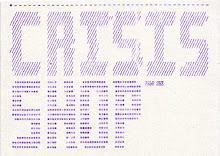
M A N I F E S T O
Designers exist solely via the simple structure of crisis in which solutions, manipulations and incarnations counterbalance perpetual problems, challenges and obstacles.
We are the mediators of fact that regurgitate inarticulate laboratory knowledge into legible three-dimensional translations.
The majority of ‘designers’ are not inventors or innovators, they are alchemists, perpetually searching for a means to create gold from the bare bones of science. Designers appropriate scientific fact and mediate this immaterial knowledge in such a way as it can perform a practical function to both the ‘user’ and big business.
We represent the lens of elucidation through which science and technology are simultaneously projected back onto the human body.
Blog Archive
-
▼
2009
(66)
-
▼
January
(15)
- R U B B E R R E S E A R C H
- http://mathworld.wolfram.com/images/eps-gif/Co
- http://farm1.static.flicr.com/20/69393351_a222f415...
- No title
- No title
- No title
- No title
- No title
- No title
- No title
- Lodgemore Mill, StroudWorking with the structure o...
- No title
- “Perpetual crisis” led to the notion of “No time f...
- The Myth of Progress in Design“History is not an a...
- Platform 10 Perpetual Crisis BlogHow can we turn ...
-
▼
January
(15)
Wednesday 21 January 2009
R U B B E R R E S E A R C H

Thursday 15 January 2009



Wednesday 14 January 2009








 Went for some advice from chair caner, Kevin Hubbard.
Went for some advice from chair caner, Kevin Hubbard.







































